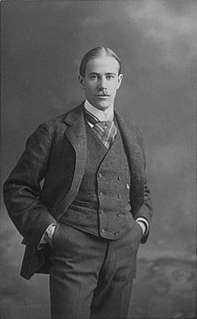Louis Agassiz Fuertes
| Louis Agassiz Fuertes | |
|---|---|
|
Louis Agassiz Fuertes | |
| Born |
February 7, 1874 Ithaca, New York |
| Died |
August 22, 1927 (aged 53) Unadilla, New York |
| Occupation | Ornithologist, illustrator and artist |
| Spouse(s) | Margaret F. Sumner |
Louis Agassiz Fuertes (February 7, 1874 Ithaca, New York – August 22, 1927 Unadilla, New York) was an American ornithologist, illustrator and artist.
He set the rigorous and current-day standards for ornithological art and naturalist depiction and is considered as one of the most prolific American bird artists, second only to his guiding professional predecessor John James Audubon.
He made untold thousands of bird paintings and sketches in various mediums, based on studies in nature and details from fresh specimens, that illustrate his extensive range of ornithological works.
Tragically, he died in a car accident near New York, shortly after returning from an expedition to Abyssinia (modern-day Ethiopia in North Africa).
To this day, his name is commemorated in two species. One is a species described by Frank Chapman as Icterus fuertesi, although it is now considered a subspecies of the orchard oriole. The other, Fuertes' parrot, or Hapalopsittaca fuertesi, was rediscovered in 2002 after 91 years of presumed extinction.
He influenced several other wildlife artists after him, in addition to mentoring George Miksch Sutton. The Wilson Ornithological Society instituted an award in his memory in 1947.
Biography

Early life
Fuertes was born in Ithaca, New York, and was the son of Estevan and Mary Stone Perry Fuertes. His father came from a prominent European-descended Puerto Rican family who was also the renown founding professor of the School of Civil Engineering at Cornell University, and for many years served as the dean of the college.
Estevan named his son after the Swiss-born American naturalist Jean Louis Rodolphe Agassiz (1807–1873). Fuertes's mother, born in Troy, was of Dutch ancestry.
Young Louis became interested in birds at very early age, securing birds with a slingshot and examining them carefully.
As a child he had been influenced by Audubon's Birds of America. At the age of fourteen, he made his first painting of a bird, a male red crossbill, from life. He learned to keep careful records of the appearance, habits and voices of birds.
In 1890 he sent a specimen that he collected to the Smithsonian and received stellar praise and glowing comments on its rarity and accuracy and in 1891, at the young age of 17, Louis became the youngest member ever named when he was inducted as Associate Member of the American Ornithologists' Union.
He was encouraged by his father's colleagues at the university including Burt G. Wilder and Liberty H. Bailey.
In June 1892, he accompanied his parents to Europe and sketched birds and animals at the Jardin de Plantes in Paris.
In September he joined the Institute of Keller, a school in Zurich, staying on for a year.[1]
Cornell University
Returning to America, he enrolled in Cornell in 1893, choosing to study architecture.
His older brother James, however shared in memoir that Louis lacked a passion for geometry and mathematics and would often fall asleep when James tried to coach him.
During one college lecture, Louis climbed out a classroom window and sat completely still in a tree to investigate a strange bird call he had never heard before.
His interest in singing led him to join the Cornell University Glee Club. In 1894, the Glee Club went on a tour to Washington, D.C., where another member of the club suggested that Louis meet his uncle Elliott Coues, who was also keenly interested in birds.
This meeting was a turning point, as Coues recognized Fuertes' talent and spread the word about his already distinguished work.
In 1895 Coues exhibited fifty of the works of Fuertes at the Congress of the American Ornithologists' Union at Washington, a meeting that Louis was unable to attend. He received the first of his many commissions for illustrating birds while still an undergraduate.
At Cornell, he was elected to the Sphinx Head Society, the oldest senior honor society at the University. He was also a member of Alpha Delta Phi which he joined having been lifelong friends with famed horticulturalist and naturalist Theodore Luqueer Mead, a former student of his father and member of the fraternity.[2]
In 1896 Coues invited Fuertes to attend the Ornithological Congress at Cambridge in England. He graduated from Cornell in 1897 and decided to work with Abbott H. Thayer.
In 1898, he made his first expedition, with Thayer and his son Gerald, to Florida.[1]
Career and personal life
In 1898, he made his first expedition, with Thayer and his son Gerald, to Florida.[1] In 1899, Fuertes accompanied E. H. Harriman on his famous exploration of the Alaska coastline, the Harriman Alaska Expedition.
Fuertes later traveled across much of the United States and to many countries in pursuit of birds, including the Bahamas, Jamaica, Canada, Mexico, Colombia, and Ethiopia. Fuertes collaborated with Frank Chapman, curator of the American Museum of Natural History, on many assignments including field research, background dioramas at the museum, and book illustrations. While on a collecting expedition with Chapman in Mexico, Fuertes discovered a species of oriole. Chapman named it Icterus fuertesi, commonly called Fuertes’s oriole after his friend.[3]
In 1904 Fuertes married Margaret F. Sumner and they had a son, Louis Sumner, and a daughter, Mary.[1]
Fuertes regularly lectured on ornithology at Cornell University from 1923.
In 1926–27 he participated in the Chicago Field Museum/Daily News Abyssinian (Ethiopia) Expedition led by Wilfred Hudson Osgood. He produced some of his most exquisite bird and mammal watercolors as a result of this trip.
On his return he visited Frank Chapman at Tannersville, New York.
Returning from the meeting, his car was hit by a train at a railroad crossing near Unadilla, New York. A load of hay had concealed the oncoming train. His wife was seriously injured but survived.
By a prophetic twist of fate, the paintings he carried however all survived undamaged.
This extraordinary and rare collection was later purchased from Mrs. Fuertes by C. Suydam Cutting.[1][4]
Many of Fuertes' paintings still remain popular and in very high demand today. In particular, a 1924 oil painting, Wild Turkey, sold for $86,250 at a January 2012 auction in New York and his other works command even higher prices to private collectors around the world.
Fuertes' love of animals and landscapes comes through in his paintings; there is a notable vivacity and excitement present in his work that has created long-term value.[5]
Selected works
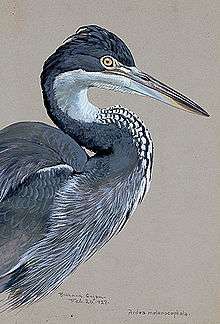
Fuertes' earliest commissions included 25 large decorative panels for F. F. Brewster of New Haven, Connecticut. This was followed by some murals at the Flamingo Hotel, of Miami, Florida and some paintings for the New York Zoological Society. He was much sought after later, illustrating books, plates for journals and magazine.[6][7] Working with impressions from the field and from freshly collected specimens, Fuertes' works are considered some of the most accurate and natural depictions of birds. He had an ability to capture the bird in action and reproduce illustrations from a mental image.[8][9] Apart from illustrations, he wrote some full length articles including one on falconry in the National Geographic and another on dogs.[10][11] The cover of the journal Auk published by the American Ornithologists' Union was designed by Fuertes.[12] Some of the books that he illustrated include:
- A-Birding on a Bronco, by Florence A. Merriam, 1896 (scanned)
- Citizen Bird by Mabel Osgood Wright and Elliot Coues. Macmillan Company, 1896 (1923 reprint)
- Song Birds and Water Fowl, by H E Parkhurst, 1897 (scanned)
- Bird Craft, by M. Osgood Wright, 1897 (1900 reprint)
- The Woodpeckers, by F H Eckstorm, 1901 (scanned)
- Second Book of Birds, by Olive Thorne Miller (pseudonym of Mrs. Harriet Mann Miller), 1901 (scanned)
- Birds of the Rockies, by Leander S. Keyser 1902 (scanned)
- Handbook of Birds of Western North America, by Frank Chapman, 1902 (1904 reprint)
- Upland Game Birds, by Edwyn Sandys and T S van Dyke, 1902 (scanned)
- Key to North American Birds by Elliot Coues, 1903 (scanned)
- Handbook of Birds of Eastern North America, by Frank M. Chapman, 1904 (scanned)
- Birds of New York by Elon Howard Eaton, 1910 (scanned)
- Wild Animals of North America by Edward W. Nelson, 1918 9 scanned)
- The Burgess Bird Book for Children, by Thornton W. Burgess, 1919 (https://archive.org/details/cu31924090252812)
- Birds of Massachusetts and Other New England States by Edward Howe Forbush, 1925 (1927 edition)
- Artist and Naturalist in Ethiopia by Wilfred Hudson Osgood. Garden City: Doubleday, Doran and Co., 1936
- The Bird Life of Texas by Harry Church Oberholser. University of Texas Press, 1974
Honors and memorials
In 1927, the Boy Scouts of America made Fuertes an Honorary Scout, a new category of Scout created that same year. This distinction was give to "American citizens whose achievements in outdoor activity, exploration and worthwhile adventure are of such an exceptional character as to capture the imagination of boys...". The other eighteen who were awarded this distinction were: Roy Chapman Andrews; Robert Bartlett; Frederick Russell Burnham; Richard E. Byrd; George Kruck Cherrie; James L. Clark; Merian C. Cooper; Lincoln Ellsworth; George Bird Grinnell; Charles A. Lindbergh; Donald Baxter MacMillan; Clifford H. Pope; George Palmer Putnam; Kermit Roosevelt; Carl Rungius; Stewart Edward White; Orville Wright.[13]
Apart from mentoring George Miksch Sutton, Fuertes influenced many later wildlife artists including Roger Tory Peterson and Jörg Kühn. The Wilson Ornithological Society established the Louis Agassiz Fuertes Award in 1947.[14] Fuertes also painted dozens of mammal portraits for The National Geographic Magazine in 1916 and 1918, and inspired the Society to hire an artist of their own, Walter A. Weber.[15]
.jpg) Cardinal, from Citizen Bird (1897)
Cardinal, from Citizen Bird (1897) Eastern kingbird, from The Second Book of Birds (1901)
Eastern kingbird, from The Second Book of Birds (1901) Williamson's sapsucker, from Birds of the Rockies (1902)
Williamson's sapsucker, from Birds of the Rockies (1902)- Chestnut-backed chickadee, from Harriman Alaska Series (1904)
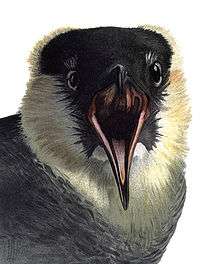 Pomarine jaeger, from Harriman Alaska Series (1904)
Pomarine jaeger, from Harriman Alaska Series (1904)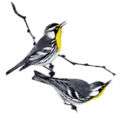 Yellow-throated warbler, from Warblers of North America (1907)
Yellow-throated warbler, from Warblers of North America (1907)- Great horned owl, from United States Department of Agriculture Yearbook (1908)
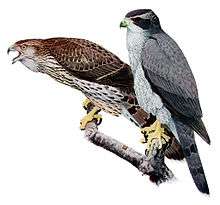 Goshawk, from Birds of New York (1910–1914)
Goshawk, from Birds of New York (1910–1914)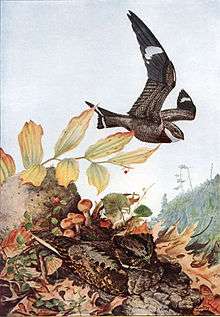 Nightjars, from Birds of New York (1910–1914)
Nightjars, from Birds of New York (1910–1914) Pileated woodpecker, from Birds of New York (1910–1914)
Pileated woodpecker, from Birds of New York (1910–1914) Magnolia warbler, from The Warblers of North America (National Geographic, 1917)
Magnolia warbler, from The Warblers of North America (National Geographic, 1917) White-faced ibis, from Game Birds of California (1918)
White-faced ibis, from Game Birds of California (1918) Silvery-cheeked hornbill, from Album of Abyssinian Birds and Mammals (1930)
Silvery-cheeked hornbill, from Album of Abyssinian Birds and Mammals (1930) Black-bellied bustard, from Album of Abyssinian Birds and Mammals (1930)
Black-bellied bustard, from Album of Abyssinian Birds and Mammals (1930) African fish eagle, from Album of Abyssinian Birds and Mammals (1930)
African fish eagle, from Album of Abyssinian Birds and Mammals (1930)- Flamingo mural at the American Museum of Natural History
References
- 1 2 3 4 5 Chapman, Frank M. (1928). "In memoriam: Louis Agassiz Fuertes 1874-1927" (PDF). Auk. 45 (1): 1–26. doi:10.2307/4075351.
- ↑ Mead, Theodore L. (1935). "Theodore L. Mead - Naturalist, Entomologist and Plantsman. An Autobiography". Yearbook, American Amaryllis Society 2: 11–22
- ↑ Peck, Robert McCracken (1982). A Celebration of Birds, The Life and Art of Louis Agassiz Fuertes. Walker and Company. p. 126. ISBN 0-8027-0716-5.
- ↑ Johnsgard, Paul A. (2008). "Louis A. Fuertes and the Zoological Art of the 1926–1927 Abyssinan Expedition of The Field Museum of Natural History".
- ↑ The Winter Sale 2012. Boston, MA: Copely Fine Art Auctions, 2012. Print.
- ↑ Marcham FG, ed. (1972). Louis Agassiz Fuertes and the Singular Beauty of Birds. Joanna Cotler Books. p. 9. ISBN 978-0-06-012775-6.
- ↑ Osgood, Wilfred H. (1927). "Louis Agassiz Fuertes". Science. 66 (1716): 469–472. doi:10.1126/science.66.1716.469. PMID 17843732.
- ↑ Wells, David T. (1909). "Drawing wild birds in their native haunts" (PDF). The Outing Magazine. 54 (5): 568–569.
- ↑ Chapman, Frank M. (1937). "Fuertes and Audubon: A Comparison of the Work and Personalities of Two of the World's Greatest Bird Artists". Natural History. 39: 205–212.
- ↑ Fuertes, LA (1920). "Falcony, the sport of Kings". The National Geographic Magazine. 38 (6): 429–626.
- ↑ Ernest Harold Baynes, Louis Agassiz Fuertes (1919). The Book Of Dogs – An Intimate Study Of Mankind's Best Friend. The National Geographic Society.
- ↑ Anon (1913). "Notes and news" (PDF). Auk. 30 (1): 157. doi:10.2307/4071947.
- ↑ "Around the World". Time (magazine). August 29, 1927. Retrieved 2007-10-24.
- ↑ Jackson, Jerome A. (1988). "The Wilson Ornithological Society in the Last Third of Its First Century: 1956–1988" (PDF). The Wilson Bulletin. 100 (4): 632–649.
- ↑ Wild Animals of North America. National Geographic, 1960. Page 7.
Other sources
- Boynton, Mary Fuertes (Ed.) 1956. Louis Agassiz Fuertes: his life briefly told and his correspondence. Oxford University Press.
- Norelli, Martina R. American Wildlife Painting (Fuertes, Audubon, Heade, Wilson, Thayer, Catesby) Watson-Guptill Publications, 1975. ISBN 0-8230-0217-9
External links
| Wikimedia Commons has media related to Louis Agassiz Fuertes. |
| Wikimedia Commons has media related to Citizen Bird (Wright). |
- Cornell University online collection image database
- Scans of some bird paintings, Cornell collection
- Abyssinian Birds and Mammals: Painted from life by Louis Agassiz Fuertes (1930) scanned version
 "Fuertes, Louis Agassiz". Encyclopedia Americana. 1920.
"Fuertes, Louis Agassiz". Encyclopedia Americana. 1920.- "Hillhouse Family Genealogy: Register Report of Abraham Hillhouse". Retrieved March 8, 2011.
- Works by Louis Agassiz Fuertes at Project Gutenberg
- Works by or about Louis Agassiz Fuertes at Internet Archive
- Works by Louis Agassiz Fuertes at Biodiversity Heritage Library
